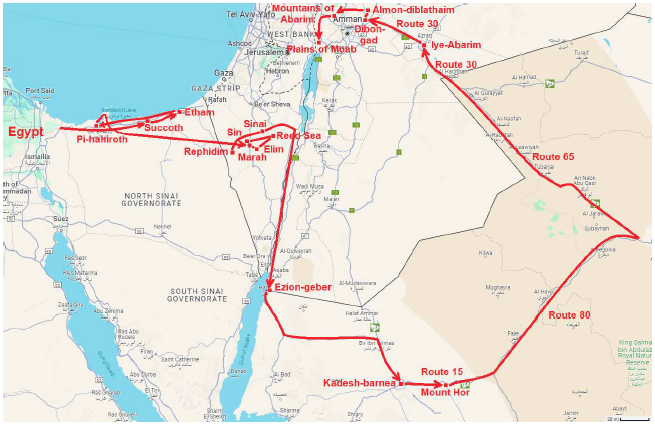
 | |
| Volume 14, Number 12 | July 16, 2024 |
Iye-abarim (also designated Iyeabarim, Iyim, Ijim, or even Iim) is the name given to the thirty-seventh encampment in the official Numbers 33:1–49 list of Exodus encampments. It is followed by Dibon-gad, Almon-diblathaim, Mountains of Abarim, and Plains of Moab, the final four encampments, in that order.
And they journeyed from Oboth, and camped at Iye-abarim, at the border of Moab. And they journeyed from Iyim, and camped at Dibon-gad. And they journeyed from Dibon-gad, and camped at Almon-diblathaim. And they journeyed from Almon-diblathaim, and camped in the mountains of Abarim, before Nebo. And they journeyed from the mountains of Abarim, and camped in the plains of Moab by the Jordan opposite Jericho. (Numbers 33:44–48)
We now know the locations of these final four encampments as well as the true location of the Arnon river, which functioned as the northern border of Moab (Figure 1). This knowledge provides the foundation needed to locate Iye-abarim. I propose that it was located at the site of the modern town of Azraq, Jordan (Figure 2).
 |
 |
The pieces of evidence supporting this proposal are enumerated below:
Azraq is situated on the road which the Israelites were traveling (modern Route 30) on their way to Dibon-gad, as Figure 2 shows.
The site of Azraq is a natural oasis with abundant water, and adequate water supply was necessarily a major consideration for any Exodus encampment site.
[Azraq] lies in the middle of the Azraq oasis…[1]Millions of cubic meters of freshwater attracted camel caravans…[2]
There is no other nearby source of fresh water.
[The] Azraq oasis [is] the only permanent source of fresh water in approximately 12,000 km2 (4,600 sq mi) of desert.[3]
Azraq is located at an appropriate distance from the next encampment, Dibon-gad. There were five encampments following Mount Hor (encampment 33) to get to Dibon-gad (encampment 38). The distance from Mount Hor to Dibon-gad, measured via Google Maps, is about 440 miles. This yields an average distance of (440/5=) 88 miles between encampments for this portion of the journey. So encampments are expected to be spaced out at greater than a single day's journey (30 miles) in this part of the route. The distance between Azraq and the Dibon-gad encampment is about 44 miles, a journey of one and a half days.
The name, Iye-abarim, means "ruins of Abarim," implying previous habitation at this site long before the Israelites arrived there. Azraq abundantly satisfies this requirement.
Archaeological evidence indicates that Azraq has been occupied for hundreds of thousands of years…Azraq has long been an important settlement in a remote and now-arid desert area of Jordan.[4]
The location is right relative to the location of Moab. The historical narrative found in Numbers 21 records:
And they journeyed from Oboth, and camped at Iyeabarim, in the wilderness which is opposite Moab, to the east. (Numbers 21:11)Azraq is both "in the wilderness" and "opposite Moab, to the east."
The Biblical Chronologist (ISSN 1081-762X) is written and edited by Gerald E. Aardsma, Ph.D. (nuclear physics) with special background in radioisotopic dating methods such as radiocarbon, and is published by: Aardsma Research & Publishing Copyright © 2024 by Aardsma Research & Publishing. Unless otherwise indicated, scripture quotations are taken from the (NASB®) New American Standard Bible®, Copyright© 1960, 1971, 1977, 1995 by The Lockman Foundation. Used by permission. All rights reserved. www.Lockman.org } |